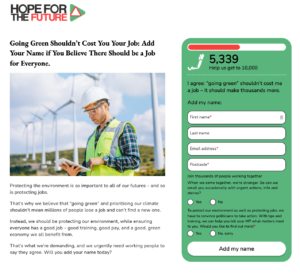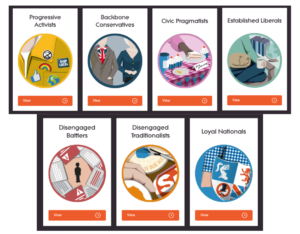In our November webinar, Hope for the Future’s Sarah Jordan and Forward Action’s Jessie Hayes talked through findings from a project exploring how organisations can engage new people beyond their traditional supporter base.
Campaigning organisations usually know their core audience well and have successful tactics for recruiting them. But in order to grow and accelerate change, they need to be able to appeal to a wider pool of people, and inspire them to become passionate supporters too.
Our project used insights from the Britain Talks Climate (BTC) toolkit to find out whether Hope for the Future – a climate communications charity – could successfully appeal to groups that looked very different to its established supporter base.
We were also testing the BTC research findings, to see whether they could be effectively used to reach specific audiences online.
So, what did we do?
BTC is designed to help organisations engage the public on climate change. It identifies seven segments within the British population, giving detailed personas for each one plus guidance on how to adjust messaging to appeal to each group’s core values and motivations.
Hope for the Future’s supporter base is largely made up of Progressive Activists. So for this project, we focused on reaching out to people in three of the other segments: Disengaged Traditionalists and Disengaged Battlers (both cold audiences), and Established Liberals (a warm audience).

We then set out to recruit people from these groups following an approach that looked like this:

During a creative session, we used detailed insights from BTC to discuss the core values and worldview of people in each segment, as well as any red flags (ie, messaging that might put them off). We then came up with different messaging framings to target each segment, and developed these into three handraisers per audience, making nine in total.
Handraisers are sign-up pages which rely on a low bar, values-based action and minimal data input to recruit supporters, and then follow this with a secondary ask – in this case, completing a 16-question survey to find out whether the handraisers were attracting the intended audiences.

These are the nine framings we tested, with links to the handraisers:
Disengaged traditionalists
- Going green shouldn’t cost you your job.
- Feeling left out of the chat on climate change?
- Working people need to stand together to fight the climate crisis
Disengaged battlers
- It’s time for British leadership on the climate
- Our British seaside towns are at risk
- “I want a safe climate for my children and grandchildren.”
Established liberals
- We’re all doing our bit: now the Government needs to do theirs
- Your voice could convince others to act on climate change
- Let’s not let our European partners down
We promoted each handraiser using nine Facebook ads. This meant we could test a range of copy and image combinations and optimise spending to focus on the best performing variants.
What results did we get?
The campaign results were strong: 8,274 people signed a handraiser, 74.3% of them opted in to receive emails, and 55.4% went on to complete the survey.
So, with over 4,000 responses we were able to calculate with a high degree of accuracy who our campaigns had reached. A couple of results stood out:
- Among Disengaged Traditionalists the seaside towns handraiser performed significantly better than the other two, with 9.8% of respondents coming from our target segment, as opposed to 1.1% and 2.5%. This showed the value of testing more than one framing.
- The seaside towns handraiser also appealed to the widest range of people. 35% of signers were Progressive Activists, while the rest came from a broad spread of groups.
…And what did we learn?
- Everyone cares about the climate. As expected, the handraisers attracted significant numbers of Progressive Activists, Hope for the Future’s existing audience. But they also pulled in people from across the other six segments.
- Interrogating messaging works. Thinking about people’s worldview, values and red flags was important for understanding how to appeal to different segments. For example, Disengaged Battlers characteristically feel disempowered, they value validation, respect and feeling heard, and they’re put off by false positivity and false promises.
- A longer survey didn’t deter people. We would usually recommend six to 10 questions, but needed to use a 16-question survey from BTC to allocate people to the right segments. It probably helped that we told people at the start that no personal data would be stored.
- Comments on the ads were varied. Because the campaigns used strong messaging and reached a broad audience, there was a lot of debate in the comments beneath each ad.
- One segment really surprised us… Although we didn’t target Loyal Nationalists, they consistently made up the biggest proportion of responders after Progressive Activists. Hope for the Future noted that LNs can be influential messengers, especially with Conservative MPs. So this represented a really exciting opportunity to be explored further.
What’s next?
Building on the findings from this project, we’re now doing further work to reach out to Loyal Nationalists and Disengaged Battlers, and encourage them to engage in higher bar actions.
How could this help you?
Much of the learning from this project can be applied by other organisations to reach new audiences. Here are a few things to think about:
1. Use the BTC toolkit
Although it was developed for the climate sector, the toolkit is backed by extensive, reliable research and is a useful resource for any campaigning organisation. The kit contains:
- all the research and guidance about the seven segments
- a how-to guide that takes you through the process of setting up a similar digital campaign
- information to help you target the audience segments in your Facebook ad campaigns.
2. Review your messaging
Use audience personas to review your key messaging and calls to action. Don’t just think about demographics or characteristics, focus on people’s values. Ask what they think about the world, what inspires them and what puts them off. Look for common ground as well as differences.
3. Get buy-in for a test and learn approach
Drive action, create lots of variants (both images and copy), and let the data decide which ads and handraisers you scale up and invest most budget in. Don’t expect quick rewards, interrogate all the data you can and be ready to follow new opportunities (eg, HFTF targeting Loyal Nationalists).
Q&A
Q. How long did you run the campaign for, what was the average cost per sign-up and how many people did you recruit overall?
Jessie, Forward Action: We ran the campaign for eight weeks from November to January, with a break for Christmas, when cost per lead shot up. The average cost per opted in lead was 84p, which was good for us as our target was below £1. And the number of people we recruited was over 6000.
Q. What tools did you use to create the handraiser?
Jessie: We used Blueprint, a template Forward Action has developed for handraisers and sign-up pages. The survey was built in Typeform, which is a slick, inexpensive survey and quiz builder.
Q. Did you plan different ongoing communications approaches for the different audiences?
Sarah, Hope for the Future: No, because the main focus for this project was on which audiences were engaging with the initial handraisers and opting in for emails. We created a welcome series of emails that was quite general and we hoped would engage all audiences. In a follow-on project we’re currently running, we’re looking into this more and seeing which audiences go on to take further, higher bar actions.
Q. How did you set up your Facebook ads to hit the different segments?
Jessie: Part of the aim of this project was to test BTCs audience research to see whether we could use it to attract the segments we wanted to. So, we went out to a broad audience for all the ads. We wanted to try and ensure that if there was a difference in results, it was because of our messaging, not anything else. In a project we’re currently doing, we’re testing both broad audiences and the Facebook audiences BTC have since developed for each segment.
Q. Were you worried about comments on the ads undermining your careful messaging approach?
Sarah: For us, it felt like a good opportunity to demonstrate how we engage with people who don’t have a similar worldview, by focusing on values and not getting involved in arguments. Of course, we didn’t have control over how other people responded to that, so that was a bit of a concern.
Jessie: I think the main concern for us was, is the debate in the comments affecting the cost per lead by distracting people from taking action? We monitored that really carefully. Obviously, Hope for the Future also had a policy of removing anything that was abusive or inappropriate. It was also a good opportunity to reflect on why the messaging might make people respond in that way.
Q. Was the creative workshop based on perception and existing understanding, or were there new insights informing it?
Jessie: It was based on an understanding of BTC’s research. We were trying to take those insights into each segment and use them to work out what messaging Hope for the Future could offer each group that would appeal to them. That led to generating the headlines for the handraisers.
Sarah: While we were trying to engage new audiences, we were also really careful about not losing our own messaging, who we are and our voice. So it was really helpful to bring the two together in that session. We didn’t want to only talk to one audience or alienate our existing audience.
Q. What was the resource needed to create all the campaign collateral (ads, graphics, surveys), in terms of time and energy?
Jessie: That was all done in-house by Forward Action’s creative team. We developed 81 ads and nine handraisers because we were being really apprehensive – as the first organisation to test the BTC data, we wanted to cover all bases in case only one of the handraisers worked as intended. I’d say that if you’ve got a campaign or messaging that you wanted to align it with already, you could just do three handraisers and 27 ads.
Q. With the upcoming Facebook changes to interest terms and targeting, do you think this research and testing would be harder to do again?
Jessie: This particular research shouldn’t be because we went out to broad audiences. What it will affect, I believe, is the mapping BTC have done of the segments onto FB audiences. I don’t currently know whether they have any plans to revisit and adjust that.
We hope this post has given you new ideas and approaches to help you reach out to new audiences online. If you still have questions, or if you’d like support to develop your digital mobilisation work, we’re always happy to chat.
Our webinars take place every other month and cover a different topic within digital fundraising, campaigning and mobilisation each time. Follow us on Twitter to hear about our next one.


